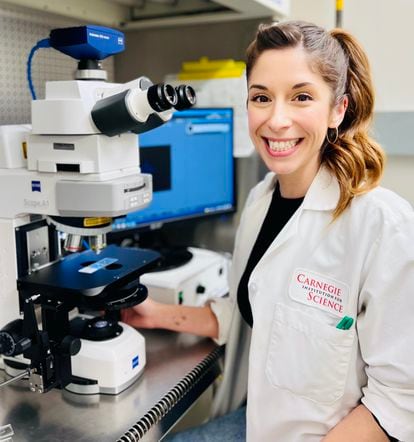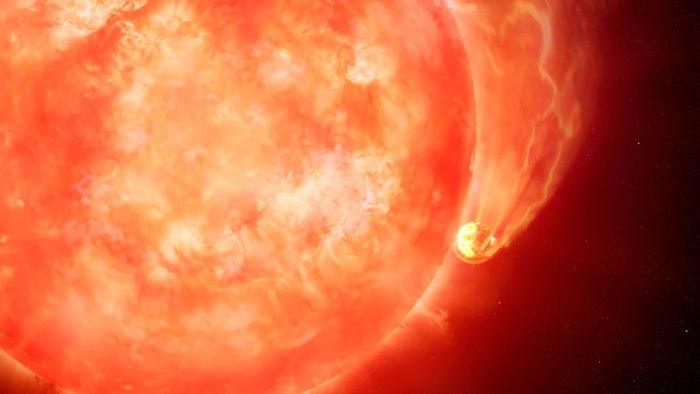The study of a microscopic microbe that lives in lakes and seas today clarifies how one of the most important chapters in the evolution of life on Earth happened: the appearance of complex cells 2.5 billion years ago.
All animals, plants, and fungi are made of various eukaryotic cells, which have internal organelles unlike unicellular bacteria and archaea.
Most scientists think that its origin is in a microbe that swallowed another.
Instead of digesting it as it had done until then, a spontaneous relationship of dependence took place—the large microbe provided protection from the outside and the small one, food.
2.5 billion years of joint evolution later, thousands of mitochondria related to that devoured microbe float inside each of our cells and transform food into the energy needed by the brain to think or the heart to beat.
Thanks to other organelles —chloroplasts— plants can feed on light by doing photosynthesis.
The appearance of the modern cell "was a revolution for the evolution of life on Earth," summarizes Victoria Calatrava, a biochemist at the Carnegie Institution of Science (USA).
"Without it our planet would not look anything like how we see it today, nor would we be here to tell about it," she adds.
The objective of this 32-year-old woman from Cordoba is to demonstrate exactly how this union happened.
It is a devilish question because the molecular traces have been almost completely diluted after so much time.
Biochemist Victoria Calatrava in her laboratory at the Carnegie Institute of Science (USA).Carnegie
Calatrava leads a study that sheds light on the origin of our cells by studying the aquatic microbe
Paulinella micropora
.
This organism is the union of an amoeba that devoured a cyanobacterium, a microbe capable of photosynthesis.
This type of endosymbiosis has only occurred twice in the entire history of evolution.
One happened 1.5 billion years ago and gave rise to the chloroplasts that provide energy to all plants.
The second is that of
Paulinella
, which happened just 120 million years ago.
This makes her a living fossil.
Many of the traces erased by evolution in other organisms are still visible in this amoeba.
In a study published today in the journal
PNAS,
of the US National Academy of Sciences, Calatrava and the rest of his team explain how the union of two such different living beings happened, which in turn could well explain what happened. 2.5 billion years ago with the appearance of mitochondria in the first complex cell.
Genes from the photosynthetic bacteria began to jump out of it and into the genome of the host amoeba.
A process known as retrotransposition caused some genes to be copied many times and function more efficiently.
Scientists have shown that this adaptation process allowed the amoeba to enhance genes that allow it to tolerate toxic compounds associated with photosynthesis, which would otherwise have killed it during mating.
It was an irreversible step.
The bacterium gave up so many genes that it could no longer live on its own, and its host changed its metabolism so much that it would be unable to return to being a predator.
"Both benefit from the existence of the other and are completely dependent," explains Calatrava, who invites us not to see this process as something kind.
“I don't think it's a cooperative relationship in which both win the game;
rather they have no choice but to keep each other alive so as not to become extinct, ”he highlights.
This condemnation to share resources continues to characterize life on Earth.
Just think that a person is made up of 30 billion human cells and contains another 39 billion bacteria that live in their digestive system.
Without them you could not digest food.
The bacteria, in return, gain an environment with fewer predators than outside the body.
Nothing prevents these relationships from breaking down, as is often the case with infections caused by antibiotic-resistant bacteria.
These organisms that threaten to reverse the greatest advances in medicine exchange resistance mechanisms using a gene transfer process similar to that described in the amoeba
Paulinella
.
"Our results suggest that this mechanism has been crucial for the domestication of foreign genes in the context of endosymbiosis and it seems very likely that it has been key to the stabilization of endosymbionts and the evolution of organelles in other systems", Calatrava highlights.
Juli Peretó, an expert in synthetic biology at the University of Valencia, highlights the importance of this study.
“Life on Earth arose about 3.5 billion years ago in the form of bacteria and archaea.
They invented respiration and photosynthesis.
1,000 million years later, an archaea engulfed a bacterium and complex cells arose.
And another 1,000 million years later, a new union appears between photosynthetic bacteria and another microbe that gives rise to the chloroplasts that carry out photosynthesis in plants.
This work on
Paulinella
is like an isolated frame that allows us to reconstruct the film of how it all started”, he highlights.
"It makes sense that everything happened in the way this study proposes, although it is difficult to determine," says Toni Gabaldón, a researcher at the Barcelona Center for Genomic Regulation.
The biologist believes that the exchange of genes between the bacterium and the amoeba was like someone discarding once and going from having a partner to poker: a process of accelerated improvement.
The only thing that remains to be shown is whether this lucky move explains the origin of all eukaryotes or only those that carry out photosynthesis.
In this race to clarify the origins of our cells,
Paulinella
has a clear competitor: the archaea of Asgard.
Two years ago, Japanese scientists announced that they had successfully bred these creatures outside their deep-sea habitat for the first time.
The researchers believe that it is another living fossil.
These organisms measure one ten-thousandth of a centimeter and reproduce very slowly by microbe standards, about once a month.
The most striking are its long intertwined tentacles.
Scientists don't yet know what they use them for, but they think they're essential in explaining how complex life arose from organisms very much like them.
"The discovery of the archaea of Asgard will help us a lot to understand the origin of complex cells," says Iñaki Ruiz-Trillo, a researcher at the Institute of Evolutionary Biology.
“I am optimistic and I believe that we will be able to clarify this issue.
We know much more now than we did 20 years ago, and we will know more in time.
Even any day a new basal eukaryote or a new archaea can give us clues that we can't even dream of right now”, he highlights.
You can follow
MATERIA
on
,
and
, or sign up here to receive
our weekly newsletter
.








